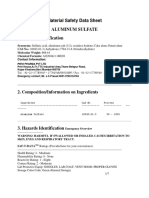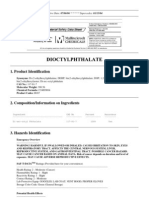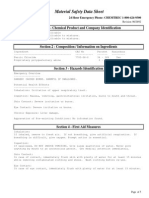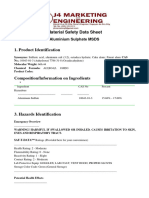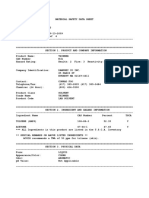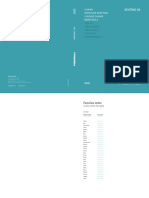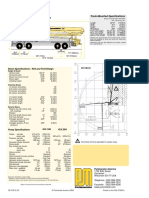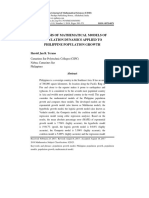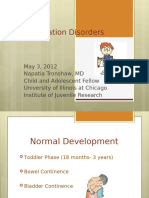Phenolphthalein: 1. Product Identification
Phenolphthalein: 1. Product Identification
Uploaded by
Stuart Campos GuerraCopyright:
Available Formats
Phenolphthalein: 1. Product Identification
Phenolphthalein: 1. Product Identification
Uploaded by
Stuart Campos GuerraOriginal Title
Copyright
Available Formats
Share this document
Did you find this document useful?
Is this content inappropriate?
Copyright:
Available Formats
Phenolphthalein: 1. Product Identification
Phenolphthalein: 1. Product Identification
Uploaded by
Stuart Campos GuerraCopyright:
Available Formats
MSDS Number: P2015 * * * * * Effective Date: 04/02/07 * * * * * Supercedes: 02/16/06
PHENOLPHTHALEIN
1. Product Identification
Synonyms: 3,3-bis(p-hydroxyphenyl) phthalide; 3,3-bis(4-hydroxyphenyl)-1(3H)-isobenzofuranore
CAS No.: 77-09-8
Molecular Weight: 318.33
Chemical Formula: C20H14O4
Product Codes:
J.T. Baker: 2870, 2872
Mallinckrodt: 6600
2. Composition/Information on Ingredients
Ingredient CAS No Percent Hazardous
--------------------------------------- ------------ ------------ ---------
Phenolphthalein 77-09-8 100% Yes
3. Hazards Identification
Emergency Overview
--------------------------
WARNING! HARMFUL IF SWALLOWED. SUSPECT CANCER HAZARD. CONTAINS PHENOLPHTHALEIN WHICH MAY CAUSE CANCER. Risk of
cancer depends on level and duration of exposure.
SAF-T-DATA(tm) Ratings (Provided here for your convenience)
-----------------------------------------------------------------------------------------------------------
Health Rating: 2 - Moderate (Cancer)
Flammability Rating: 1 - Slight
Reactivity Rating: 0 - None
Contact Rating: 1 - Slight
Lab Protective Equip: GOGGLES; LAB COAT; VENT HOOD; PROPER GLOVES
Storage Color Code: Green (General Storage)
-----------------------------------------------------------------------------------------------------------
Potential Health Effects
----------------------------------
Inhalation:
Nuisance dust. May cause coughing and sneezing.
Ingestion:
Cathartic. Very active, even in small amounts (30-100 mg). May cause purging, collapse, and fall of blood pressure or an itching skin rash that can become ulcerous.
Other systemic effects are not well known.
Skin Contact:
Not classified as an irritant but may be absorbed via moist or oily surfaces. Symptoms may resemble those from ingestion exposure.
Eye Contact:
Slight irritant.
Chronic Exposure:
Suspect cancer hazard; contains phenolphthalein which may cause cancer. Risk of cancer depends on level and duration of exposure.
Aggravation of Pre-existing Conditions:
Persons with pre-existing skin disorders or impaired respiratory function may be more susceptible to the effects of the substance.
4. First Aid Measures
Inhalation:
Remove to fresh air. Get medical attention for any breathing difficulty.
Ingestion:
Induce vomiting immediately as directed by medical personnel. Never give anything by mouth to an unconscious person. Get medical attention.
Skin Contact:
Wash exposed area with soap and water. Get medical advice if irritation develops.
Eye Contact:
Immediately flush eyes with plenty of water for at least 15 minutes, lifting upper and lower eyelids occasionally. Get medical attention if irritation persists.
5. Fire Fighting Measures
Fire:
As with most organic solids, fire is possible at elevated temperatures or by contact with an ignition source.
Explosion:
Fine dust dispersed in air in sufficient concentrations, and in the presence of an ignition source is a potential dust explosion hazard.
Fire Extinguishing Media:
Dry chemical, foam or carbon dioxide.
Special Information:
In the event of a fire, wear full protective clothing and NIOSH-approved self-contained breathing apparatus with full facepiece operated in the pressure demand or other
positive pressure mode.
6. Accidental Release Measures
Remove all sources of ignition. Ventilate area of leak or spill. Wear appropriate personal protective equipment as specified in Section 8. Spills: Clean up spills in a
manner that does not disperse dust into the air. Use non-sparking tools and equipment. Reduce airborne dust and prevent scattering by moistening with water. Pick up
spill for recovery or disposal and place in a closed container.
7. Handling and Storage
Keep in a tightly closed container, stored in a cool, dry, ventilated area. Protect against physical damage. Containers of this material may be hazardous when empty since
they retain product residues (dust, solids); observe all warnings and precautions listed for the product.
8. Exposure Controls/Personal Protection
Airborne Exposure Limits:
None established.
Ventilation System:
A system of local and/or general exhaust is recommended to keep employee exposures as low as possible. Local exhaust ventilation is generally preferred because it can
control the emissions of the contaminant at its source, preventing dispersion of it into the general work area. Please refer to the ACGIH document, Industrial Ventilation,
A Manual of Recommended Practices, most recent edition, for details.
Personal Respirators (NIOSH Approved):
For conditions of use where exposure to dust or mist is apparent and engineering controls are not feasible, a particulate respirator (NIOSH type N95 or better filters) may
be worn. If oil particles (e.g. lubricants, cutting fluids, glycerine, etc.) are present, use a NIOSH type R or P filter. For emergencies or instances where the exposure levels
are not known, use a full-face positive-pressure, air-supplied respirator. WARNING: Air-purifying respirators do not protect workers in oxygen-deficient atmospheres.
Where respirators are required, you must have a written program covering the basic requirements in the OSHA respirator standard. These include training, fit testing,
medical approval, cleaning, maintenance, cartridge change schedules, etc. See 29CFR1910.134 for details.
Skin Protection:
Wear protective gloves and clean body-covering clothing.
Eye Protection:
Use chemical safety goggles. Maintain eye wash fountain and quick-drench facilities in work area.
9. Physical and Chemical Properties
Appearance:
White to pale yellow crystals.
Odor:
Odorless.
Solubility:
Slightly soluble in water.
Density:
1.299
pH:
No information found.
% Volatiles by volume @ 21C (70F):
No information found.
Boiling Point:
Not applicable.
Melting Point:
258 - 262C (496 - 504F)
Vapor Density (Air=1):
No information found.
Vapor Pressure (mm Hg):
No information found.
Evaporation Rate (BuAc=1):
No information found.
10. Stability and Reactivity
Stability:
Stable under ordinary conditions of use and storage.
Hazardous Decomposition Products:
Carbon dioxide and carbon monoxide may form when heated to decomposition.
Hazardous Polymerization:
Will not occur.
Incompatibilities:
Strong oxidizing agents.
Conditions to Avoid:
Incompatibles.
11. Toxicological Information
No LD50/LC50 information found relating to normal routes of occupational exposure. Investigated as a tumorigen and mutagen.
--------\Cancer Lists\------------------------------------------------------
---NTP Carcinogen---
Ingredient Known Anticipated IARC Category
------------------------------------ ----- ----------- -------------
Phenolphthalein (77-09-8) No Yes None
12. Ecological Information
Environmental Fate:
No information found.
Environmental Toxicity:
No information found.
13. Disposal Considerations
Whatever cannot be saved for recovery or recycling should be managed in an appropriate and approved waste disposal facility. Processing, use or contamination of this
product may change the waste management options. State and local disposal regulations may differ from federal disposal regulations. Dispose of container and unused
contents in accordance with federal, state and local requirements.
14. Transport Information
Not regulated.
15. Regulatory Information
--------\Chemical Inventory Status - Part 1\---------------------------------
Ingredient TSCA EC Japan Australia
----------------------------------------------- ---- --- ----- ---------
Phenolphthalein (77-09-8) Yes Yes Yes Yes
--------\Chemical Inventory Status - Part 2\---------------------------------
--Canada--
Ingredient Korea DSL NDSL Phil.
----------------------------------------------- ----- --- ---- -----
Phenolphthalein (77-09-8) Yes Yes No Yes
--------\Federal, State & International Regulations - Part 1\----------------
-SARA 302- ------SARA 313------
Ingredient RQ TPQ List Chemical Catg.
----------------------------------------- --- ----- ---- --------------
Phenolphthalein (77-09-8) No No No No
--------\Federal, State & International Regulations - Part 2\----------------
-RCRA- -TSCA-
Ingredient CERCLA 261.33 8(d)
----------------------------------------- ------ ------ ------
Phenolphthalein (77-09-8) No No No
Chemical Weapons Convention: No TSCA 12(b): No CDTA: No
SARA 311/312: Acute: Yes Chronic: Yes Fire: No Pressure: No
Reactivity: No (Pure / Solid)
WARNING:
THIS PRODUCT CONTAINS A CHEMICAL(S) KNOWN TO THE STATE OF CALIFORNIA TO CAUSE CANCER.
Australian Hazchem Code: None allocated.
Poison Schedule: None allocated.
WHMIS:
This MSDS has been prepared according to the hazard criteria of the Controlled Products Regulations (CPR) and the MSDS contains all of the information required by
the CPR.
16. Other Information
NFPA Ratings: Health: 1 Flammability: 1 Reactivity: 0
Label Hazard Warning:
WARNING! HARMFUL IF SWALLOWED. SUSPECT CANCER HAZARD. CONTAINS PHENOLPHTHALEIN WHICH MAY CAUSE CANCER. Risk of cancer
depends on level and duration of exposure.
Label Precautions:
Wash thoroughly after handling.
Label First Aid:
If swallowed, induce vomiting immediately as directed by medical personnel. Never give anything by mouth to an unconscious person. Get medical attention.
Product Use:
Laboratory Reagent.
Revision Information:
MSDS Section(s) changed since last revision of document include: 3.
Disclaimer:
************************************************************************************************
Mallinckrodt Baker, Inc. provides the information contained herein in good faith but makes no representation as to its comprehensiveness or accuracy. This
document is intended only as a guide to the appropriate precautionary handling of the material by a properly trained person using this product. Individuals
receiving the information must exercise their independent judgment in determining its appropriateness for a particular purpose. MALLINCKRODT BAKER,
INC. MAKES NO REPRESENTATIONS OR WARRANTIES, EITHER EXPRESS OR IMPLIED, INCLUDING WITHOUT LIMITATION ANY
WARRANTIES OF MERCHANTABILITY, FITNESS FOR A PARTICULAR PURPOSE WITH RESPECT TO THE INFORMATION SET FORTH
HEREIN OR THE PRODUCT TO WHICH THE INFORMATION REFERS. ACCORDINGLY, MALLINCKRODT BAKER, INC. WILL NOT BE
RESPONSIBLE FOR DAMAGES RESULTING FROM USE OF OR RELIANCE UPON THIS INFORMATION.
************************************************************************************************
Prepared by: Environmental Health & Safety
Phone Number: (314) 654-1600 (U.S.A.)
You might also like
- ADVANCED - Chapter 6 - Element Birth and Death (UP19980818)Document9 pagesADVANCED - Chapter 6 - Element Birth and Death (UP19980818)Rory Cristian Cordero RojoNo ratings yet
- MSDS SikloheksanolDocument11 pagesMSDS Sikloheksanolsupriyanto suhonoNo ratings yet
- White Paper To Mok - FINAL-1Document26 pagesWhite Paper To Mok - FINAL-1William Mook67% (3)
- Potassium Acid Phthalate: 1. Product IdentificationDocument6 pagesPotassium Acid Phthalate: 1. Product IdentificationSiti Suwaibatul AslamiahNo ratings yet
- Dextrose, Anhydrous: 1. Product IdentificationDocument5 pagesDextrose, Anhydrous: 1. Product IdentificationCindy SofianNo ratings yet
- Tartaric Acid: 1. Product IdentificationDocument6 pagesTartaric Acid: 1. Product IdentificationLayfloNo ratings yet
- MSDSDocument7 pagesMSDSBhuvnesh9020No ratings yet
- MSDS Soda Ash LightDocument7 pagesMSDS Soda Ash Lightmandalika anugrahNo ratings yet
- Material Safety Data Sheet Calcium Lactate: Qingdao, Shandong, ChinaDocument5 pagesMaterial Safety Data Sheet Calcium Lactate: Qingdao, Shandong, ChinaFajarRachmadiNo ratings yet
- MSDS Buffer pH4Document4 pagesMSDS Buffer pH4Chengkc2014No ratings yet
- Ammonium Ferric SulphateDocument5 pagesAmmonium Ferric SulphateHussain MarzooqNo ratings yet
- Trisodium PhosphateDocument8 pagesTrisodium PhosphateAhmed ShahzadNo ratings yet
- Sucrose: 1. Product IdentificationDocument7 pagesSucrose: 1. Product IdentificationSiThu KhineNo ratings yet
- K4Fe (CN) 6Document7 pagesK4Fe (CN) 6SetsunaNo ratings yet
- 097 Potassium HydroxideDocument10 pages097 Potassium Hydroxideeng20072007No ratings yet
- Msds Caco3 PDFDocument9 pagesMsds Caco3 PDFTb Dilyas Firda AffandiNo ratings yet
- 9.glauber Salt-Sateri SdsDocument7 pages9.glauber Salt-Sateri Sdsshaffat.ecrNo ratings yet
- Glycerin MSDSDocument5 pagesGlycerin MSDSBill RichardsonNo ratings yet
- Oryx, Salt-MsdsDocument6 pagesOryx, Salt-MsdsMarg ConveyorsNo ratings yet
- Tris Base MSDSDocument4 pagesTris Base MSDSharveyNo ratings yet
- MSDS RgasDocument3 pagesMSDS RgasNg NgNo ratings yet
- Msds Aluminium Sulfat (Hidrat)Document7 pagesMsds Aluminium Sulfat (Hidrat)AlyaNo ratings yet
- Potassium ThiocyanateDocument5 pagesPotassium ThiocyanateHussain MarzooqNo ratings yet
- Edta MSDS PDFDocument4 pagesEdta MSDS PDFharveyNo ratings yet
- Propanoic Acid JTBakerDocument7 pagesPropanoic Acid JTBakerkarthikeyanNo ratings yet
- Sodium Hypochlorite Solution: 1. Product IdentificationDocument6 pagesSodium Hypochlorite Solution: 1. Product IdentificationAnonymous fCNknAf8No ratings yet
- 4-Aminoantipyrine: 1. Product IdentificationDocument6 pages4-Aminoantipyrine: 1. Product Identificationmilene2014No ratings yet
- Zinc Chloride (MSDS)Document6 pagesZinc Chloride (MSDS)Rizky RitongaNo ratings yet
- Buffer Sol PH7Document5 pagesBuffer Sol PH7Hussain MarzooqNo ratings yet
- MSDS DopDocument5 pagesMSDS DopHenry WinsonNo ratings yet
- Benzoato de SodioDocument7 pagesBenzoato de SodioJennyferNo ratings yet
- Borax MsdsDocument6 pagesBorax MsdsNina FloydNo ratings yet
- MSDS Ammonium MolybdateDocument6 pagesMSDS Ammonium MolybdateAuliarhamdaniNo ratings yet
- MSDS LW 1200Document7 pagesMSDS LW 1200nalljaNo ratings yet
- Stoving Paint MsdsDocument9 pagesStoving Paint MsdsrajangangarNo ratings yet
- Citrato Férrico AmoniacalDocument8 pagesCitrato Férrico Amoniacalcome gli uccelliNo ratings yet
- MSDS BeralexDocument7 pagesMSDS Beralexnarendrakumara33No ratings yet
- Aqua Hawk 104 MSDSDocument5 pagesAqua Hawk 104 MSDSJohn AtkinsNo ratings yet
- Oxalic Acid MsdsDocument5 pagesOxalic Acid MsdsAbdul QadeerNo ratings yet
- Hoja de Seguridad Fe-25Document8 pagesHoja de Seguridad Fe-25camiloayalaNo ratings yet
- Benzyl AlcoholDocument5 pagesBenzyl AlcoholHussain MarzooqNo ratings yet
- FM200 MSDSDocument7 pagesFM200 MSDSMohd A IshakNo ratings yet
- Nickel (II) Sulfate JTBakerDocument7 pagesNickel (II) Sulfate JTBakerGreace Io SimtoNo ratings yet
- Barium Chloride Purified1kgDocument6 pagesBarium Chloride Purified1kgHussain MarzooqNo ratings yet
- CRC 3065 Belt DressingDocument3 pagesCRC 3065 Belt DressingBatanNo ratings yet
- MSDS Aluminium Sulphate 1 - 240422 - 111547Document7 pagesMSDS Aluminium Sulphate 1 - 240422 - 111547Irene ViosNo ratings yet
- CYCLOHEXANEDocument7 pagesCYCLOHEXANEEceNo ratings yet
- MF7134 MSDSDocument5 pagesMF7134 MSDSDwi Yerlis RahmiNo ratings yet
- Boric Acid: 1. Product IdentificationDocument7 pagesBoric Acid: 1. Product Identificationjesusruizbadra357No ratings yet
- HFC 227ea MsdsDocument7 pagesHFC 227ea Msdsdlemmetjies07No ratings yet
- Safety Data Sheet 9210356 Rosemount en 70976Document4 pagesSafety Data Sheet 9210356 Rosemount en 70976Nshmi-usNo ratings yet
- Nitric Acid 69-72%Document6 pagesNitric Acid 69-72%Hussain MarzooqNo ratings yet
- Thinners MSDSDocument7 pagesThinners MSDSManuel CardosoNo ratings yet
- Material Safety Data Sheet MSDS Non FerricDocument8 pagesMaterial Safety Data Sheet MSDS Non FerricGURMEET SINGH100% (1)
- Ca (NO3) 2Document6 pagesCa (NO3) 2Anonymous cgKtuWzNo ratings yet
- Vanilla Color Stabilizer SDSDocument5 pagesVanilla Color Stabilizer SDSMr. EYESNo ratings yet
- MSDS - John Deere Cool-Gard Pre-Dilute CoolantDocument5 pagesMSDS - John Deere Cool-Gard Pre-Dilute CoolantBatanNo ratings yet
- HP3Document4 pagesHP3Maria Francesca MapaNo ratings yet
- MSDS Sodium HydrosulfiteDocument5 pagesMSDS Sodium HydrosulfiteSarker ChotonNo ratings yet
- KPC Drilling Rig AcceptanceDocument3 pagesKPC Drilling Rig Acceptanceislam atifNo ratings yet
- C73x-X73x-C74x-X74x PS FRUs Module Rev1.0Document8 pagesC73x-X73x-C74x-X74x PS FRUs Module Rev1.0Pedro MachadoNo ratings yet
- Pedrali Chair 3Document139 pagesPedrali Chair 3muhammadNo ratings yet
- Manual Discover 150 SDocument80 pagesManual Discover 150 SStef Incio17% (6)
- Family Poultry Production PDFDocument18 pagesFamily Poultry Production PDFMnrNo ratings yet
- RM400 Wear Part TrainingDocument18 pagesRM400 Wear Part TrainingMp pmNo ratings yet
- Human Robotic Interaction Seminar Report On 2018-19Document26 pagesHuman Robotic Interaction Seminar Report On 2018-19MusthafaNo ratings yet
- Evolution of Thermally Induced White Etching Layer at Rail Surface During Multiple Wheel - Train PassagesDocument13 pagesEvolution of Thermally Induced White Etching Layer at Rail Surface During Multiple Wheel - Train Passagesanime MAVCNo ratings yet
- Scarab Merlin Hydrostatic Technical SpecificationsDocument4 pagesScarab Merlin Hydrostatic Technical SpecificationsScarab SweepersNo ratings yet
- Astrology in England in The Twenty-First Century Bernard EcclesDocument58 pagesAstrology in England in The Twenty-First Century Bernard EcclesKlaus-BärbelvonMolchhagenNo ratings yet
- MathDocument148 pagesMathNoel nmh100% (1)
- Acid in SoapDocument2 pagesAcid in Soapedgar.geb5937No ratings yet
- CentoCancer® Comprehensive With Genes 1Document5 pagesCentoCancer® Comprehensive With Genes 1Muhammad Nabeel IlyasNo ratings yet
- Ornamental PDFDocument301 pagesOrnamental PDFmrsmech84No ratings yet
- Basic Mathematics - I Subject Code 04UMA 1401 Hours Per Week 8 Credit 5 UNIT - 1Document28 pagesBasic Mathematics - I Subject Code 04UMA 1401 Hours Per Week 8 Credit 5 UNIT - 1Parijat Digambar Bhangale50% (2)
- 42M - Putzmeister SpecsDocument1 page42M - Putzmeister Specshomam gamilNo ratings yet
- MS103030561 PDFDocument11 pagesMS103030561 PDFHarold Jan TeranoNo ratings yet
- Training Manual ABDocument125 pagesTraining Manual ABOanh Lê Thị Lâm100% (1)
- Astronomy: Branch of Astronomy Field of AstronomyDocument14 pagesAstronomy: Branch of Astronomy Field of AstronomyAnnNo ratings yet
- Marine Main EngineDocument116 pagesMarine Main Enginenicoletabytax100% (11)
- Guide: Overclocking FX-8350 To 4.8GHz On Crosshair V Formula-ZDocument7 pagesGuide: Overclocking FX-8350 To 4.8GHz On Crosshair V Formula-ZBobapatatasNo ratings yet
- Metasurface Antennas For Synthetic Aperture RadarDocument192 pagesMetasurface Antennas For Synthetic Aperture Radardtvt2006No ratings yet
- Castrol Gear OilsDocument4 pagesCastrol Gear OilsgambitoxdNo ratings yet
- MTW Owner's ManualDocument18 pagesMTW Owner's ManualrhokahinNo ratings yet
- Elimination DisordersDocument30 pagesElimination DisordersizmsherNo ratings yet
- Industrial Training ReportDocument28 pagesIndustrial Training ReportIdowu OjoNo ratings yet
- Ultimate Strength of Fillet Welded Connections Loaded in PlaneDocument13 pagesUltimate Strength of Fillet Welded Connections Loaded in PlanePatrick PolujanNo ratings yet
- Heat Capacity at Constant Pressure of Inorganic and Organic Compounds in The Ideal Gas State Fit To A Polynomial CPDocument2 pagesHeat Capacity at Constant Pressure of Inorganic and Organic Compounds in The Ideal Gas State Fit To A Polynomial CPilvisoctavioNo ratings yet






















